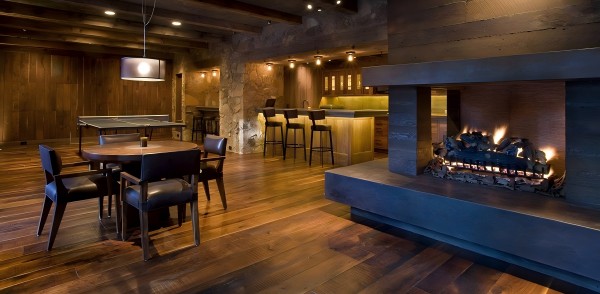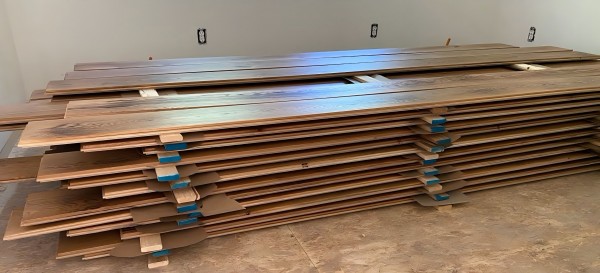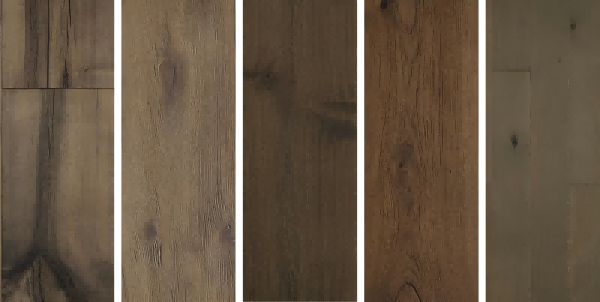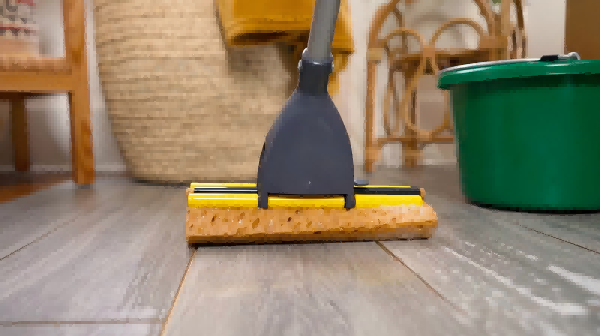Installing engineered wood flooring in a basement can be an excellent way to elevate the appearance and comfort of the space. Engineered wood offers a unique blend of aesthetics, durability, and versatility, making it an appealing choice for many homeowners. However, basements present unique challenges due to their specific environmental conditions, including moisture levels, temperature fluctuations, and potential flooding. As a result, careful consideration and preparation are necessary before installing engineered wood flooring in a basement.
This article will guide you through the important factors to consider when installing engineered wood flooring in the basement, covering aspects such as space, humidity, moisture control, subfloor preparation, acclimation, and maintenance. By understanding these elements, you can ensure the longevity and performance of your engineered wood floors while avoiding potential problems like warping, buckling, or mold growth.

Table of Contents
ToggleUnderstanding the Environmental Conditions in the Basement
Before diving into the installation process, it is crucial to understand the environmental conditions of the basement. Unlike the main levels of a home, basements tend to have unique challenges such as higher humidity, temperature fluctuations, and poor ventilation. These factors can significantly affect the condition of engineered wood flooring if not properly addressed.
Humidity and Moisture Concerns
Basements are inherently more humid than the rest of the house due to their below-ground level. Moisture from the surrounding soil can seep into the basement, making it prone to dampness and even flooding during heavy rainstorms or snowmelt. Excess moisture can lead to wood expansion, warping, and, in some cases, mold growth. Therefore, moisture control is one of the most critical factors to consider when installing engineered wood flooring in a basement.
Engineered wood is more resistant to moisture than solid hardwood because of its layered construction. However, it is not immune to moisture damage. High humidity can still cause the wood to swell, expand, or buckle, leading to permanent damage. If the basement has an existing moisture problem, it may be necessary to address these issues before installing any flooring.
Space Size and Ventilation
Another aspect of the basement environment that should not be overlooked is the size of the space and its ventilation. Basements tend to be smaller and more confined, which can affect airflow and circulation. Without proper ventilation, moisture levels can rise, exacerbating the risk of floor damage. You should ensure that the basement is adequately ventilated to allow airflow and minimize moisture buildup.
For larger basements, it is essential to use dehumidifiers to maintain an optimal humidity level. The recommended relative humidity level for basements is between 30% and 50%. This range will help prevent mold growth while also preserving the integrity of your engineered wood flooring.
Subfloor Preparation
Proper subfloor preparation is essential when installing engineered wood flooring in any space, but it becomes even more important in basements. The subfloor must be clean, dry, level, and structurally sound to support the engineered wood planks.
Moisture Barrier Installation
Since basements are prone to moisture issues, it is essential to install a moisture barrier beneath the engineered wood flooring. A vapor barrier, typically made from polyethylene plastic, acts as a barrier to prevent moisture from the subfloor from rising up into the flooring. Without this moisture barrier, moisture can seep into the engineered wood and cause it to warp, swell, or develop mold and mildew.
Installing a vapor barrier is particularly important if the basement has a concrete subfloor, as concrete is highly porous and prone to moisture seepage. The vapor barrier should be placed directly on the concrete before laying down the underlayment or flooring. Be sure to overlap the seams of the vapor barrier to ensure a continuous seal.
Leveling the Subfloor
Engineered wood floors require a flat and level subfloor to ensure proper installation and performance. If the basement’s subfloor is uneven, the engineered wood flooring may buckle, creak, or fail to lay flat. Before installation, check the subfloor for any uneven areas, cracks, or holes.
For concrete subfloors, you may need to level the surface using a self-leveling compound. This will create a smooth and even surface for the flooring to adhere to. If the basement has a wood subfloor, it should be securely fastened and in good condition, with no squeaky or loose boards.
Acclimation of Engineered Wood Flooring
Acclimation refers to the process of allowing the engineered wood flooring to adjust to the temperature and humidity of the installation space before installation. This is especially important in basements due to their often fluctuating humidity levels.
When engineered wood flooring is manufactured, it is typically stored in a climate-controlled environment. Upon delivery to the basement, the flooring planks must be allowed to acclimate to the space’s environmental conditions. Failing to do so can result in the wood expanding or contracting after installation, which could cause warping or gaps between planks.
How to Acclimate the Flooring
To acclimate the flooring, remove the planks from their packaging and allow them to rest in the basement for at least 48 to 72 hours before installation. The temperature in the basement should be maintained between 60°F and 80°F (16°C and 27°C) to facilitate proper acclimation. During this time, the humidity should also be within the recommended range of 30% to 50%.
Do not stack the planks directly on the concrete floor or other surfaces. Allow them to breathe by spacing them apart slightly to ensure airflow around the planks.
Choosing the Right Engineered Wood Flooring
Not all engineered wood flooring is created equal, and choosing the right product for your basement is essential for a long-lasting, successful installation. When selecting engineered wood flooring for a basement, consider the following factors:
Water-Resistant Core
Some engineered wood flooring comes with a water-resistant or waterproof core, which is beneficial in basements. These types of floors are designed to resist moisture and provide added protection against potential water issues. For areas that are more prone to moisture, it’s worth investing in a more water-resistant product to avoid floor damage over time.
Thickness of the Planks
The thickness of the engineered wood planks can also impact their durability. Thicker planks tend to be more stable and less prone to warping. Opt for planks that are at least 3/8 inches thick for better performance in the basement environment.
Finish and Sealing
Many engineered wood floors come with a pre-applied finish, such as a polyurethane coating, which provides additional protection against moisture. Be sure to choose a product that has a high-quality finish to prevent moisture from penetrating the wood surface.
Installation Methods for Engineered Wood Flooring
There are several installation methods for engineered wood flooring, and the method you choose will depend on the type of subfloor and the specific product you are using. Common installation methods include:
Glue-Down Installation
This method involves applying adhesive to the subfloor before laying down the engineered wood planks. It works well for concrete subfloors, as the adhesive helps to seal the flooring and prevent moisture from seeping through. Glue-down installation can also provide better stability and durability over time.
Floating Floor Installation
In a floating floor installation, the planks are not glued or nailed to the subfloor but instead “float” over the surface. This method is ideal for installations over existing floors, such as concrete or plywood, and can be easier and quicker than glue-down methods. However, it is essential to ensure the subfloor is properly prepared, level, and clean before installation.
Nail or Staple Installation
While less common for engineered wood floors, some products allow for nail or staple installation. This method is more suitable for wood subfloors and may require special fasteners to secure the planks in place.
Ongoing Maintenance and Care
Once the engineered wood flooring is installed, regular maintenance and care will help ensure its longevity. In basements, maintenance becomes even more critical due to the increased risk of moisture and humidity fluctuations.
Use Dehumidifiers
To keep the humidity levels in check, invest in a good-quality dehumidifier for the basement. This will help control moisture levels and reduce the risk of floor damage. Make sure to regularly empty the dehumidifier and monitor the humidity levels to maintain optimal conditions for your engineered wood floor.
Seal the Floor
It is essential to periodically check the finish and sealing of your engineered wood flooring. If the finish begins to wear, consider reapplying a protective sealant to safeguard the wood from moisture damage.
Cleaning and Prevention
Clean the floor regularly using a dry or slightly damp mop to avoid excess moisture buildup. Avoid using harsh chemicals or excessive water when cleaning, as these can damage the wood surface. Additionally, placing area rugs or mats near doors and windows can help reduce dirt, debris, and moisture from entering the space.
Conclusion
Installing engineered wood flooring in a basement requires careful planning and attention to detail. Understanding the environmental factors, preparing the subfloor, properly acclimating the flooring, and choosing the right product are essential steps to ensure a successful installation. By taking these precautions, you can enjoy beautiful, durable, and long-lasting engineered wood floors in your basement without the worry of warping, swelling, or other moisture-related issues.
Investing time and resources into proper preparation and maintenance will provide you with a comfortable, aesthetically pleasing basement space that adds value and enhances the overall look and feel of your home.



